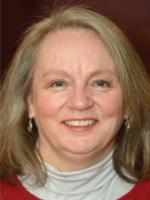Charna Albert
December 2019—There aren’t good flu seasons; there are just varying degrees of how bad they are.
That’s the message the CDC wants people to hear, says Lynnette Brammer, MPH, lead for the CDC’s domestic influenza surveillance team. It’s what laboratories know well and why platforms, panels, and prescribing patterns are top of mind.

Brammer
The 2018–2019 flu season was unusually long, Brammer says. “That was probably the biggest standout. Influenza-like illness was elevated for 21 weeks. Our previous long was 20.”
When the season began, H1N1 viruses were predominant, Brammer says. “It looked like it wasn’t going to be a terrible season. And then it switched over to H3N2, which made the season long. We had never seen a season where we had two pretty much equal influenza A waves, but we did last year. And we didn’t have much B activity, which we frequently see toward the end of the season.”
The lesson reinforced by the last flu season? “Flu is unpredictable. I don’t think any of us understands the interplay of factors well enough to say, ‘This happened because of this,’” Brammer says of last season’s atypical influenza A pattern. “The best explanation I have is, ‘It’s flu, and flu is unpredictable.’”
As for this season, “Here in the U.S., we’ve seen the H3N2 viruses, H1N1 at a slightly lower level, and influenza B viruses. We’ve got everything out there; all our options are open,” she said in an interview in late September.
Australia’s flu season this year, reported to be severe, was actually moderate but early, Brammer says. “It did happen early, so activity was high for the time of year it was happening, and from what I understand there were increases in testing. When you only look at positives, it looks bad, but people were just testing more,” she says, adding that in general, “there is more and more testing done.”
As a whole the Southern Hemisphere was a “mixed bag.”
“In South America, some countries saw more H1 than H3, some saw more H3 than H1, some saw more B than others.” Australia was H3 predominant, she says, and New Zealand had more B than A. “So there’s just a mix. It’s hard to say this probably predicts what we’re going to see because sometimes it does and sometimes it doesn’t.”
Meanwhile, laboratories are weighing options and making changes.
For Arkansas Children’s at Little Rock and Springdale, the goal was to pilot a CLIA-waived rapid molecular PCR influenza A/B test (to replace the Quidel Sofia Influenza A+B fluorescent immunoassay) in the emergency department by the end of 2019, most likely the Cepheid Xpert Xpress Flu, said Sherry Childress, BSMT(ASCP), section manager of molecular diagnostics and immunology, and Bobby L. Boyanton Jr., MD, pathologist-in-chief and section medical director of molecular pathology, in a recent interview.
“This rapid molecular flu test will be used for patients presenting with influenza-like illness who are not sick enough to be admitted,” Childress says. “For patients with bronchiolitis or sick enough to be admitted, the BioFire FilmArray respiratory panel will be the front-line test.”
“We initially considered the Cepheid Xpert Xpress Flu/RSV test,” Dr. Boyanton adds. “However, RSV is not the only respiratory virus that causes bronchiolitis. Our emergency room physicians felt the BioFire Film-Array panel was more helpful in this setting.”

Childress (l), Dr. Boyanton (r)
The laboratory implemented the BioFire panel first, “but the Sofias came on board through point of care,” Childress says. If the point-of-care program hadn’t purchased the Sofias, there’s a good chance the laboratory would already have implemented rapid molecular testing, she says. “In truth, the pieces weren’t all put together as part of the big picture right from the beginning.”
Between 2018 and 2019, the laboratory upgraded to the BioFire Film-Array Respiratory Panel Two (RP2) and high-throughput Torch system. This allowed interfaced results with the laboratory information system, automatic verification of negative specimens, and trained staff on off-shifts to provide around-the-clock testing.
Before implementing the Torch and RP2, the molecular laboratory day staff fed RP tests through two FilmArray instruments. The RP test had a 65-minute run time, Childress says. “We could only do about 16 tests on the extended day shift, and we’d always have a substantial test queue each morning. The RP2 assay, which we validated with the new Torch instrument, runs in 45 minutes. With four modules on our Torch, we could run up to 45 assays on day shift.”
The laboratory began offering 24/7 RP2 Torch testing at the beginning of 2019 and it has become a “fast favorite,” Childress says. “Of course, now we’ve given a mouse a cookie. Within a couple months of 24/7 coverage, emergency department staff were calling the lab to ask for results, indicating they couldn’t let patients go home until RP2 testing was complete.” Test use from January to August 2019 increased 45 percent compared with the same period in 2018.
 CAP TODAY Pathology/Laboratory Medicine/Laboratory Management
CAP TODAY Pathology/Laboratory Medicine/Laboratory Management
